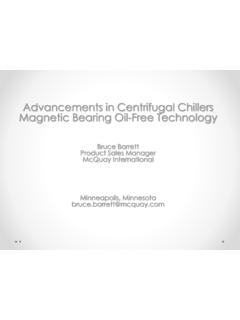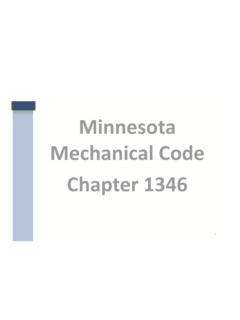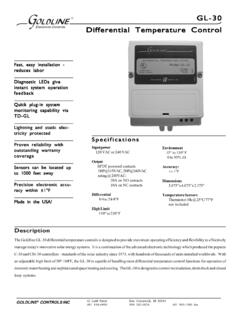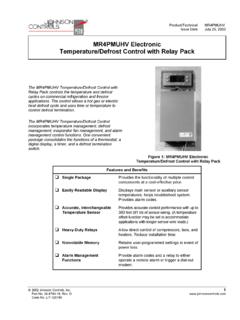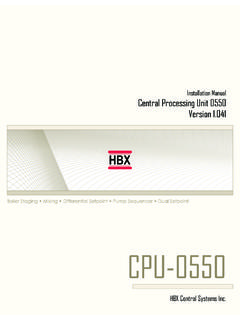Transcription of Commercial Refrigeration Temperature & Defrost Control …
1 Commercial Refrigeration Temperature & Defrost Control and Optimization Joe Dudley Regional Sales Manager KE2 Therm Solutions, Inc. Commercial Refrigeration : The unmet energy challenge Traditional Temperature Controls Pressure Controls Provides Indirect Temperature Control Thermostat Return/Discharge Air Temp Evaporator Coil Temp Product Temp Advanced Temperature Control Multiplex Rack Systems Evaporator Pressure Regulator (EPR) EPR = Steady Suction P = Steady Air Temp Good for stable load conditions Electronic Suction Regulator Controlled by microprocessor controls Flexible Control (pressure or temp) Responds to varying load conditions for improved Temperature Control Advanced Temperature Control Single Compressor Systems Hot Gas Bypass Can Provide Excellent Temperature Control Comes at an Energy Penalty Advanced Temperature Control Single Compressor Systems Utilize microprocessor controls to improve overall system performance Reduced Room Temp differential Between Cut-In & Cut-Out Compressor Short Cycle Protection (Minimum Runtime & Off-time) Evaporator Fan Management Variable Speed Evaporator Fans Should be part of overall system design Likely requires other variable capacity components (EEVs, Variable Speed Compressor, etc.)
2 Can be cost prohibitive for smaller applications Two Speed Evaporator Fans Provides energy savings during Refrigeration off-cycle Typically requires specific motor design Off-Cycle Fan Management Off-Cycle Fan Management Provides Improved Temp Control & Energy Savings Latent energy recovery through evaporator fan cycling, compressor stays off Free Cooling Latent Energy Recovery Copyright 2010 KE2 Therm Solutions, Inc. Washington, Missouri Slide - 8 Proper fan Control during operation provides free cooling by sublimating frost to chill room Light Frost Accumulation Improves Heat Transfer of the Coil Factors Affecting Frost Buildup Air Temp Humidity Coil Temp Including variations due to refrigerant flow Fin Spacing Air movement (high velocity vs.)
3 Low velocity) Common Methods of Defrost Air Defrost (Off-Time) Hot Gas Defrost Electric Defrost Air Defrost Techniques (Space Temps 36 F & Above) Natural Off-Time oRequires oversized Refrigeration system oSpace Temperature Control always active oNo guarantee the coil is defrosted Pressure/ Temperature constant cut-in/cut-out oInitiates off-cycle/defrosts in response to drop in suction temp/pressure oProvides indirect space Temperature Control oDoes provide feedback regarding Defrost effectiveness oCan be difficult to dial-in oSystem issues & load variations can fool the controls Forced Defrost oIndependent of Temperature Control oFixed Time or Temperature Terminated Hot Gas Defrost Typically Fastest Means of Defrost Melts Frost from Inside-Out Heat is Provided by Refrigeration System Higher Up Front Cost for Added Piping & Controls Hot Gas
4 Defrost Techniques Reverse Flow oTypically on Rack Systems oHot Gas is directed from Compressor Discharge or Liquid Receiver to Outlet of Evaporator oGas flows backwards through Evap and condensed liquid is directed to liquid line/header Hot Gas Defrost Techniques Three Pipe oDedicated Hot Gas line to the evaporator inlet oMust have a means of dealing with condensed liquid exiting the evap during Defrost Reverse Cycle oSingle Compressor System oReversing Valve Shifts Flow of Refrigerant Condenser Evaporator Electric Defrost Simple to Operate & Maintain Typically longer to Defrost than Hot Gas since heat has to travel from heaters to frost oSurface Mounted Heaters oHeater Elements Inserted into Coil Uses External Heat Source for Defrost Heat Up to 80% of Heat Load can be transferred to Refrigerated Space Electric Defrost Techniques Time Intitiated oTypically set for worst case and seldom adjusted oCan be Time or Temperature Terminated Runtime Defrost Schemes Adaptive Defrost Schemes oReactive oProactive Proactive Defrost Constantly Monitors System Performance Walk-In Freezer (Before) 7 day graph with Defrost timeclock set to (4) 30 minute defrosts/day Walk-In Freezer (After) As Few As 3 Defrosts in 1 Week Electric Defrost Heater Control 80% additional room heat gain (radiation + convection)
5 Due to high heater Temperature High coil Temperature drives fog into the room, can create ice build up problems Consequences of Fogging Advanced Defrost Heater Control Ensures lower coil Temperature , less energy usage, decreased product heating Only 20% additional heat gain (radiation + convection) due to heater Temperature Before - June 15, 2012 After - July 22, 2012 Results of Improved Defrost Control Defrost Termination Defrost Termination On Time oNo gaurantee coil is defrosted oDoesn t prevent addition of unnecessary heat into refrigerated space Defrost Termination on Temperature oFixed Temperature Setting vs. Adjustable oAdjustable Defrost Termination Location vs. Fixed oMore than 1 Defrost Termination Location?
6 Coil Temperature Reaching 80 F During Defrost Improved Defrost Termination THANK YOU!

